ISSN ONLINE(2319-8753)PRINT(2347-6710)
ISSN ONLINE(2319-8753)PRINT(2347-6710)
Indramani Kandi1 , Prof.Kedar Nath Das 2 and Dr. Sudipt S Mahish 3
|
| Related article at Pubmed, Scholar Google |
Visit for more related articles at International Journal of Innovative Research in Science, Engineering and Technology
In this work ,The thermal comfort properties of polyester and bamboo blended woven fabrics have been studied in relation to %of component fibers in blends ,pick density and weave .The objective was to determine the influence of fabric factors such as the constituent fibers ,pick density and weave characteristics on the fabrics properties such as air permeability ,relative water vapour permeability ,thermal resistance ,water absorbency time and wicking .thermal comfort characteristics of plain and twill woven fabrics made of 2/30s Ne bamboo in warp and 30s Ne 100% bamboo ,polyester/bamboo blended yarns have been studied .The fabric characteristics such as air permeability ,thermal resistance ,relative water vapour permeability ,water absorbency time and wicking related to comfort characteristics are discussed. The experimental results show that 2/30s ne bamboo in warp direction of twill fabrics with 60picks per inch exhibits higher wick ability as well as higher relative water vapour permeability when compared to other samples. 30s Ne polyester/bamboo (70/30) blended in weft direction of twill fabrics with 64 picks per inch show very higher thermal resistances and air permeability than other samples .And 100% bamboo in warp direction of twill fabrics with 60picks per inch show less water absorbency time than other samples.
Keywords |
| Thermal comfort ,Air permeability ,Water vapour permeability ,Thermal resistant ,Water absorbency time ,Wicking |
INTRODUCTION |
| Now a days, consumer education level is increasing, becoming more & more health conscious and they have become more careful towards their living conditions than they were previously . The main factors affecting consumers when selecting garments are aesthetic, appearance and fashion. Besides these factors ,comfort properties of garments during usage are important. Now-a-days, consumers have become much more demanding when it comes to the properties of clothing, particularly those of leisure and sportswear. One of the textile properties that have steadily gained importance among increasingly well- informed consumers are breathability of the material, because this property seems to be directly linked to comfortable wear of the garment. To be comfortable and to maintain the state of comfort, clothing must be designed to allow the body’s heat balance to be maintained under a wide range of environmental conditions and body activity.),)... Clothing comfort is an extremely complex phenomenon and has drawn the attention of many textile research workers .It can be classified into three groups namely psychological, tactile and thermal comfort .psychological comfort is mainly related to the garment style ,proper fit, fashion and suitability for the occasion and shows no relationship with the fabric properties .tactile comfort is the feel of the fabric when it is touched and it is directly related to fabric handle. the thermal comfort is the factor governed by the movement of heat ,moisture, and air through the fabric. The maintains balance is probably the most important attribute of clothing and has drawn the attention of many textile research workers .the main problem associated for thermal comfort is the incompatibility between the requirement of heat conservation during low metabolic activity and heat dissipation at high energy level. There are numerous factors regarding conditions of thermal comfort ,such as age, sex, adaption ,season and heat-flow conditions as well as physical conditions existing next to the skin surface .Bamboo fiber is a new material developed at the beginning of the 21st century .It has many characteristics that meet the current requirement of end uses .But today we still don’t know the actual performance behavior fibers in many application [8].Availability of bamboo fibers is sufficient due to the plant’s high growth rate .It is an eco-friendly ,bio-degradable ,natural antibacterial ,anti-fungal product ,having good soil release and ultra violet protection ability[4,8] .Bamboo fibers having high modulus, softness ,brightness as well as u v-protective characteristics with its high moisture absorption capacity ,breath-ability & fast drying behavior due to its unique microstructure[4] .Bamboo is a naturally occurring composite material which grows abundantly in the topical countries .It is considered a composite material because it consists of cellulose fibers imbedded in a lignin matrix which are aligned along the length of the bamboo providing maximum tensile strength ,flexural rigidity in that direction. Bamboo fibers are commonly used as, bamboo intimate apparels,sweaters,bathsuits,mats,blankets,towels,underwears,tight-t shirts ,socks & bamboo non-woven products ,sanitary material(bandage ,mask ,surgical cloth ,nurse’s wear ,mattress)&food packing bags .Bamboo fiber’s mechanical process(spinning) is same as viscose fibers[4,8] .Other properties of bamboo fibers is superior to viscose .Bamboo fiber is very low strength fiber ,which makes the spinning processes difficult due to fly generation in roving .Also the production cost of bamboo yarn is around 2.5 times that of the cotton yarn .Bamboo fibers low tensile strength decreases further when wet .In order to avail the positive attribute of the fibers at economical rate the fibers have been blended with polyester[4]. Modern day ,living condition require clothing that are hygienic ,comfortable ,hardwearing & having easy care properties .No, single textile fibers have all thus desirable attributes .Synthetic fibers like polyester have better wear &easy care properties but they lack many of the comfort & hygiene related properties .But regenerated fibers like bamboo have good moisture related properties leading to good comfort as well as good hygiene related properties but they lack wear & easy care properties .So, blended yarns composed of polyester/bamboo and fabrics produced from them can provide optimum desirable properties. So, an attempt has been made in this current research to study the different aspects of the P/B blended yarns & the thermal comfort aspects of P/B blended suiting fabrics produced by using different weaves and weft density in light weight, medium weight and heavy weight categories |
MATERIALS AND METHOD |
| 2.1 Specifications of Polyester and Bamboo Fibers |
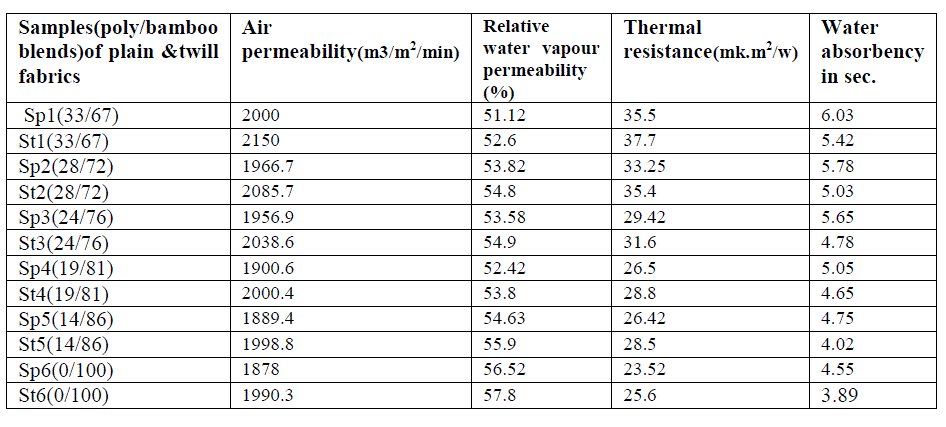 |
| 2.1.1 Some Precaution in Bamboo Yarn Production Process[4] |
| It is similar to traditional viscose yarn production process. But some minor adjustments should be required for bamboo yarn production process. Bamboo fiber producing flyings in Draw frame & Speed frame, so we should adopt a high humidity (65%-70%) and a low temperature (25°C) in Industry. High coefficient of twist should be adopted due to weak cohesion between bamboo fiber. Card web tension and roving tension should be kept low for this weak cohesion of fibres. |
| 2.1.2 Some Precaution in Bamboo Fabric Weaving [4,14] |
| Twist coefficient in the range from 350 to 410 turns per meter should be required for requirement of higher tensile strength of pure bamboo yarn for weaving in high speed modern looms. Relatively low and even tension should be maintained during warping and sizing process of bamboo yarn, because of moisture regain rate and elongation is relatively high in case of bamboo yarn. It is better to choose starch as main component of sizing agent due to hydrophilic nature of bamboo fibres. Sometimes it is better by choosing some acrylic acid as part of sizing agent rather than PVA to improve yarn softness and makes it easy to dividing the yarns and also to decreasing yarn hairiness The moisture regain rate should be kept 8-9%,because bamboo fibers are breakable when moisture regain is too low & also bamboo fibers tensile strength decreases dramatically when moisture regain rate is too high. Weaving should be maintained in lower tensions and carried out at relative humidity of 65-75%.The present study was performed in following steps. |
| 2.2 Yarn Preparation |
| Yarns of five different blends along with a100%bamboo yarn were produced on Lakshmi Rieter ring spinning in tit mill ltd after proper mixing and blending .The various yarn samples of blends,70/30,60/40,50/50,40/60 and 30/70 polyester/bamboo were prepared . The yarns produced were then wound to form cones. All the six yarns were then tested for, strength and elongation, uneven-ness and hairiness . |
| 2.3 Fabric Preparation |
| The yarns were woven as 100% bamboo yarn as warp(2/30s Ne) & six samples of polyester & bamboo blends of above yarns as weft with EPI=72 & PPI=64 ,62,60 to produced 2 types of fabrics as plain (1/1) & twill(2/2) in Laxmi (dobby )automatic sample power loom in TIT&S , Bhiwani laboratory |
| 2.4 Chemicals & treatments |
| All the fabric samples were then washed with 2 GPL soda solution & 2GPL soda ash at boil for 30 mins . Subsequently they were hot washed twice and finally cold washed. The pH was maintained at 7.The sample were then dried & ironed for testing purpose. the samples of Sp1,St1,Sp2,St2,Sp3,St3,Sp4,St4,Sp5,St5,Sp6,St6 indicating the plain fabrics and twill fabrics of polyester and bamboo blends of,70/30,60/40,50/50,40/60 and 30/70. But actual fibres % of polyester & bamboo in woven fabrics as 33/67, 28/72,24/76,19/81,14/86,0/100. |
TESTING |
| All the finished fabrics were tested for the various comfort properties in standard atmospheric condition of RH of 65%+2% and temp. of 25+ 2 degree centigrade .The properties tested were as follows |
| 3.1 Air permeability |
| The Air Permeability of the specimens was determined by the Prolific Air Permeability Tester according to the standard IS 11056-1984.The conditioned test specimen was held between two annular ring shaped grips .The test area of 10cm2 square was chosen under the pressure drop of 10mm head of water column. Vacuum pump was used to draw air through the exposed area of the test specimen. The volume of air was measured with the help of a set of rotameters . An inclined manometer is provided to indicate the difference in pressure between the two faces of the test specimen .Calculation of Air permeability of each specimen can be obtained by Air permeability=Rate of air flow /Exposed Area Or Air permeability =k X Rotameter Reading=0.01667X Rotameter Reading in m3/m2/min.,Where k=Conversion factor. |
| 3.2 Water Vapour Permeability |
| The water vapour permeability was measured on the Perme test following the standard ISO 11092. Slightly curved porous surface of the instrument is moistened (either continuously or on demand) and exposed in a wind channel to parallel air flow of adjustable velocity. A sample is located in a small distance from the wetted area of diameter about 80 mm and characterized by high thermal conductivity. The amount of evaporation heat of liquid water taken away from the active porous surface is measured by a special integrated system .Thus ,very low time constant of the whole system is achieved ,resulting in short measurement time .Full signal is registered within several minutes. |
| 3.3 Thermal Resistance |
| The thermal resistance was measured on‘Perme test’ following the standard ISO 11092. |
| The whole procedure is similar to the below described procedure on the water vapour permeability test but the measuring head is kept dry and the measuring head is maintained at the temperature 32-350C for at least 5min. |
| 3.4 Drop Test |
| A drop of water is allowed to fall from a fixed height onto the taut surface of a test specimen. The time required for the specular reflection of the water drop to disappear is measured and recorded as water absorbency time. It was measured by the standard method AATCC 79-2007 |
| 3.5 Wick ability Test |
| The vertical wicking test of the fabric was carried out according to the TAPCC standard .The conditioned specimen of 20cm X 2.5cm was cut both along the direction of weft and warp .A set up was installed which had a ring holder were the fabric was hanged vertically .A beaker having colour (red) solution of 2gpl cold brand reactive dye was taken .Each specimen was marked with a line 3cm away from its edge along its length. The specimen was then dipped inside the solution till the mark and the wicking height was noted down after an interval of 5min,10min,15min and 30min. |
RESULT AND DISCUSSION |
| The finished the suiting fabrics were subjects to various test to analyzed the thermo-physiological comfort properties and results are discuses below |
| Table 4.1; Effect of blend% and weave on air permeability, relative water vapour permeability ,thermal resistant and water absorbency time of suiting fabrics of 64ppi |
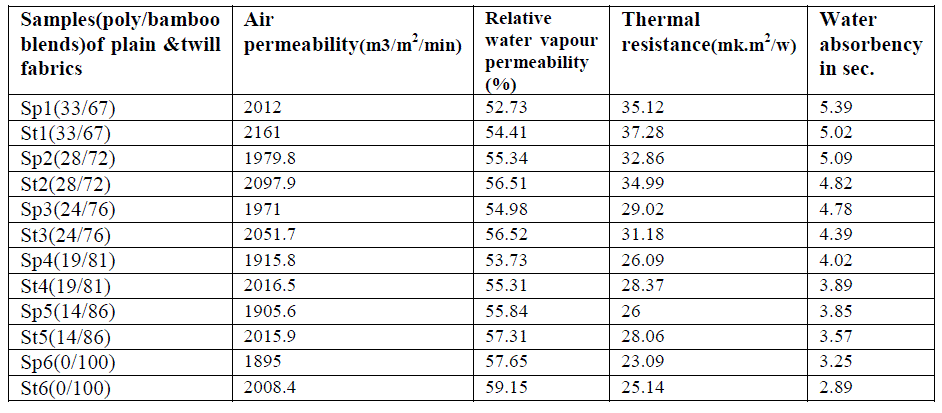 |
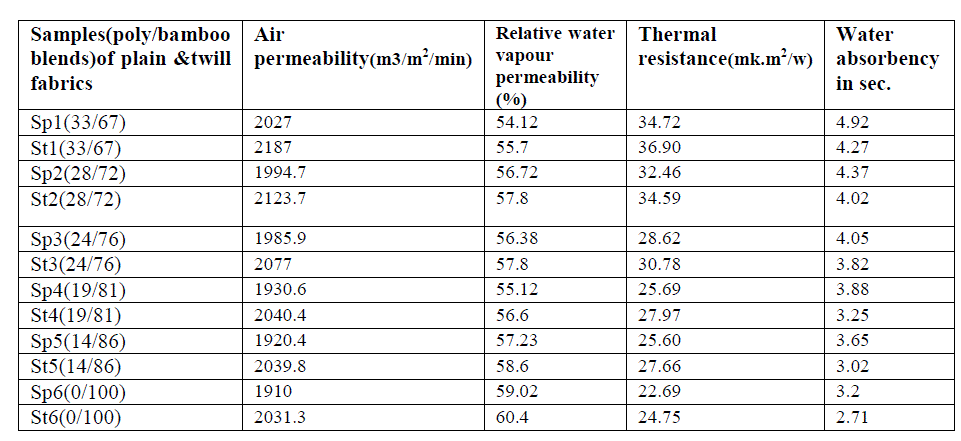 |
| It is observed from the Tables of 4.1,4.2 and 4.3 that the air permeability of the fabrics decreases with increasing bamboo content in the fabric .This can be related to the hairiness results. It has been observed that the hairiness increases with the increase in bamboo content .So the increased hairiness resists the air flow through the fabric and hence decreases the air permeability with the increasing bamboo fibres in the fabric [4,8]. There are many other factors like weave, thickness ,etc affecting the air permeability but all of these being same in the studied fabrics, blend variation may be the only reason for the air permeability[12,7 ,6]. Plain weave is less air permeable than twill weave due to compact structure of plain fabric having more interlacing points & less x-sectional area of each pore & more no. of pores .This will offer more resistance to passage of gases(air) resulting in low air permeability [2,1 ,6] and Air Permeability increase with decreasing pick density (from 64ppi to 60 ppi) due to less cover factor[6] of 60 ppi than 62ppi and 64ppi If we observe the from the above tables that the relative water vapour permeability increases with increasing bamboo content in blend as the blend comprises of polyester and bamboo .It is clear that increase in bamboo content will increase the water vapour permeability ,as it has been mentioned that the water vapour permeability of a fabric depends on the moisture regain/hygroscopic of the constituent fibres .The relative water vapour permeability generally increasing with increase of hygroscopic fibres[4,8]. Due to higher thermal insulation ,lower moisture regain of polyester fibre compared to that of bamboo ,there will be a greater difference between the environmental temp.& temp .of the layer next to the fabric ,resulting in lower evaporation of vapours[12,11,6] . For particular sett, the twill weave fabric with higher float length having higher thickness & open structure will give more water absorbing power than plain fabric .Therefore twill weave structure show more relative water vapour permeability than plain weave structure[6,4]. And relative water vapour permeability increases with decreasing of pick density (from 64ppi to 60ppi) due to less cover factor[6] of 60ppi than 62ppi and 64ppi It is observed from above tables that the thermal resistance decreases as the percentage of bamboo fibre in the blend increases .As per the results obtained from the air permeability and hairiness ,the thermal resistance should increase with increase bamboo content .But the thermal insulation value depends upon many factors of fabric, yarn and fibre[12,5].One of the reasons may be due to the nature of fibre in the blends .Bamboo fibre itself having poor thermal insulation & higher moisture regain value as compared polyester fibres will exhibit lower thermal resistance with the increase in bamboo content in the blends of fabrics[4,8] . With the increase in the bamboo fibre percentage in the blends ,air permeability of fabrics decreases but the hairiness in the yarn increases .The higher air permeability is due to bigger pores in the fabric which helps getting more air entrapped into the fabric structure .This more quantity of air will be trapped into the structure by more no .of hairs presents in the yarn .Therefore more hairiness resulting in more physical clogging of air may be increasing thermal insulation for such fabrics .Thermal insulation depends entirely on the quantity of physically trapped air into the fabric structure .So twill weaves more thermal insulation than plain weave due to thicker & bigger pore size of twill weave fabric than plain weave fabric[15,,6]. This increased flow and reduced air entrapment in the fabric structure provide more free passage for the heat to escape ,resulting in decrease in thermal insulation .Thermal resistant increases with increasing of pick density (from 60ppi to 64ppi) due to more cover factor [6] of 64ppi than 62ppi and 60ppi It is observed from the above tables that the water absorbency time decrease with increasing the Bamboo% in the blends due to hydrophilic nature of bamboo fibers[3],for particular sett, the twill weave fabrics with higher float length having higher thickness and open structure will give more water absorbing power than plain weave fabrics therefore twill weave fabrics show the less absorbency time than plain weave fabrics and the water absorbency time is increasing with increasing of pick density (from 60ppi to 64ppi) due to more cover factor [6] of 64ppi than 62ppi and 60ppi |
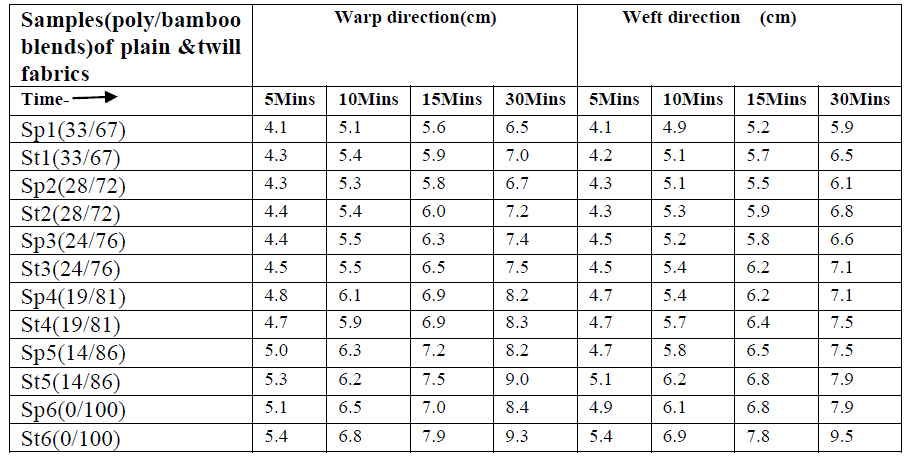 |
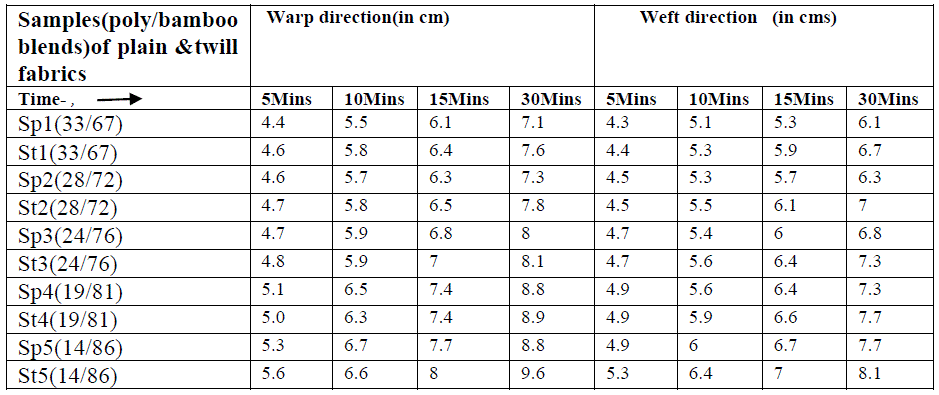 |
| Table of 4.4,4.5 and 4.6 show that the wick ability increases with increasing in bamboo content in the fabrics due to the bamboo fibre have got very good wick ability [8,4] ,which is much better than polyester. So the wick ability of the fabrics increases with increasing in bamboo fibre content(4) .It can also be observed from the tables 4.4,4.5and 4.6 .that the wick ability is more in warp direction as compared to the weft direction .This may be due to the fact that the transfer of water is easier in warp direction than weft direction due to the better capillary action in warp direction ,because of doubling of 100% bamboo fibres in the warp yarns[7] .For a particular sett ,the twill fabric shows more capillary action than plain woven fabric due to higher float length ,higher thickness & open structure of twill fabrics which provides more wick ability power than plain weave structures .Therefore twill weave fabrics have more wick ability than plain weave fabrics[6] .n due to thinner & compact structure of plain weave fabric And wick ability increases with decreasing of pick density( from 64ppi to 60ppi)due to less cover factor[6] of 60ppi than 62ppi and 64ppi |
CONCLUSION |
| From the results it is evident that variation in blends ,pick density and weave affect the thermo-physiological comfort properties of suiting fabrics .the finding are summarized as follows The air permeability of the fabrics decreases with increasing bamboo content in the blends and also increasing ppi in the fabrics. Plain woven fabric shows less air permeability than twill fabric. |
| Fabric thermal resistance decreases with increasing the percentage of bamboo fibres in the blends. and also increasing the ppi in the fabrics Twill fabric shows more thermal resistance than plain woven fabric. Relative water vapour permeability of the fabric increases with increasing bamboo content in the blends and also decreasing ppi in the fabrics Water absorbency time of the fabric decreases with increasing bamboo content in the blends .as well as decreasing ppi in fabrics water absorbency time of twill fabric is less than plain woven fabric. The wick ability increases with increasing the bamboo content in blends and also decreasing the ppi in the fabrics Fabric wick ability is more in warp direction than weft direction Twill fabric shows more wick ability than plain woven fabric. |
| INDUSTRIAL IMPORTANCE:The study will be useful for the manufacturers of suiting fabrics in terms of selection of blend percentages of polyester and bamboo fibres as well as the selection of weave and pick density while the comfort of suiting fabrics To days market is buyers market and hence ,one of the most deciding factors this fabrics may be widely used in any types of loom shed |
References |
|